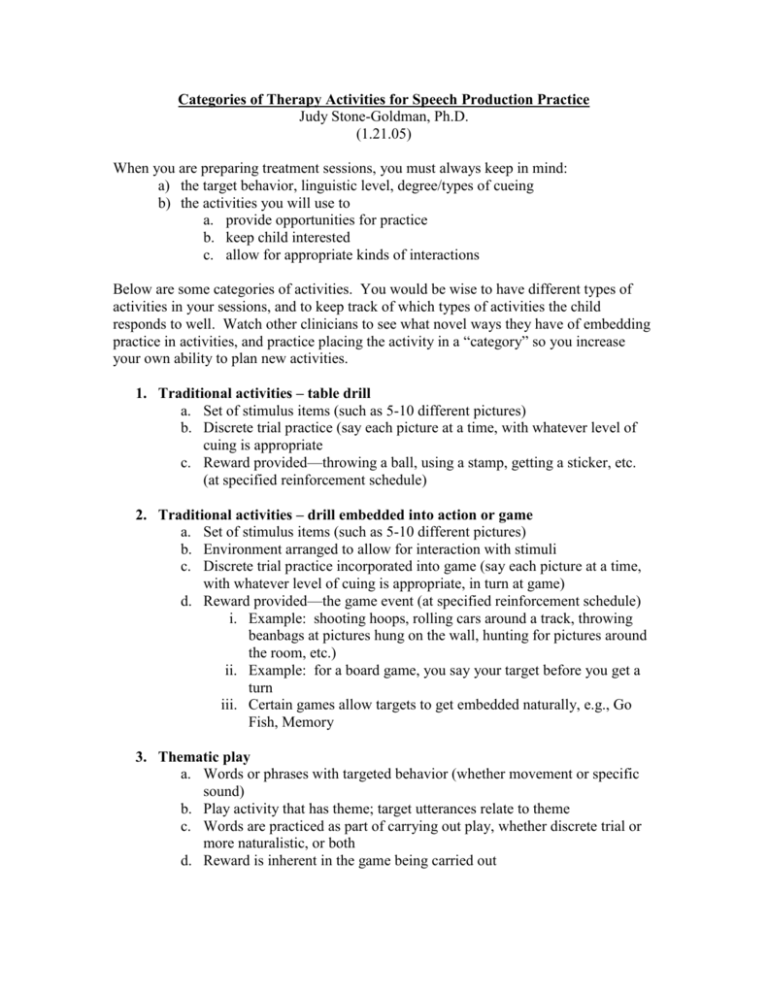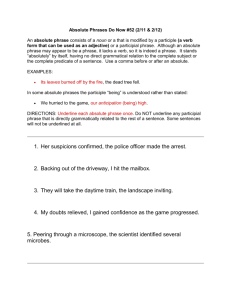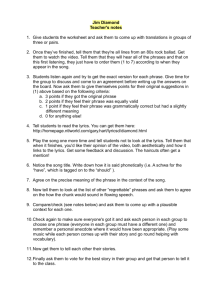Categories of Therapy Activities for Speech Production Practice
advertisement

Categories of Therapy Activities for Speech Production Practice Judy Stone-Goldman, Ph.D. (1.21.05) When you are preparing treatment sessions, you must always keep in mind: a) the target behavior, linguistic level, degree/types of cueing b) the activities you will use to a. provide opportunities for practice b. keep child interested c. allow for appropriate kinds of interactions Below are some categories of activities. You would be wise to have different types of activities in your sessions, and to keep track of which types of activities the child responds to well. Watch other clinicians to see what novel ways they have of embedding practice in activities, and practice placing the activity in a “category” so you increase your own ability to plan new activities. 1. Traditional activities – table drill a. Set of stimulus items (such as 5-10 different pictures) b. Discrete trial practice (say each picture at a time, with whatever level of cuing is appropriate c. Reward provided—throwing a ball, using a stamp, getting a sticker, etc. (at specified reinforcement schedule) 2. Traditional activities – drill embedded into action or game a. Set of stimulus items (such as 5-10 different pictures) b. Environment arranged to allow for interaction with stimuli c. Discrete trial practice incorporated into game (say each picture at a time, with whatever level of cuing is appropriate, in turn at game) d. Reward provided—the game event (at specified reinforcement schedule) i. Example: shooting hoops, rolling cars around a track, throwing beanbags at pictures hung on the wall, hunting for pictures around the room, etc.) ii. Example: for a board game, you say your target before you get a turn iii. Certain games allow targets to get embedded naturally, e.g., Go Fish, Memory 3. Thematic play a. Words or phrases with targeted behavior (whether movement or specific sound) b. Play activity that has theme; target utterances relate to theme c. Words are practiced as part of carrying out play, whether discrete trial or more naturalistic, or both d. Reward is inherent in the game being carried out i. Example: shopping (all items in store have target), restaurant (go to restaurant and order from a menu, all items have target), farm (all items have target) ii. You can do this with a set of stimuli or a repeated word/phrase iii. Some play is woven in naturally as child interacts with toys 4. Worksheet with repeated word/phrase a. Word or phrase with targeted behavior (whether movement or specific sound) b. Worksheet with content that will relate somewhat to semantics of target c. Discrete trial practice (say the word in relation to the worksheet) d. Reward related to word and worksheet i. Example: target related to using lips independently or production of phoneme /f/ ii. Picture of scene with lots of round flowers; cotton balls iii. Child says “puff” in response to stimulus presentation iv. Child gets to glue the puffball onto a flower v. Variation: art activity where targets are items being used (like “glue”) or something being drawn 5. Action game with repeated word/phrase (similar to above, but in action game) a. Word or phrase with targeted behavior (whether movement or specific sound) b. Game with content that will relate to the semantics of the target c. Discrete trial practice corresponding to events in game d. Action of game is the reward i. Example: target related to jaw control for words with /a/ [or could be for producing final /g/ in a phrase, if phoneme therapy] ii. Lily pods scattered around room; some kind of frog, whether a bean bag or plastic frog iii. Child says, “hop frog” in response to elicitation/cueing iv. Child gets to hop the frog to another lily pad 6. Board games with repeated word/phrase a. Word or phrase with targeted behavior b. Turn taking game such as board game or “Guess Who” c. Each person gets a turn and must say target word/phrase at socially appropriate time, in communication to other person d. The game itself is the reward i. Example: target related to lip rounding in phrases ii. Any board game, such as Sorry or Chutes and Ladders iii. After a turn, person says (for example), “You go” or “Your turn.” iv. Game continues 7. Board game with multiple phrases a. Same as above, but multiple phrases related to game are incorporated. b. Example: “Race to the roof” as a phrase in that game, along with “your turn, I go now,” etc. You can make this increasingly complex. 8. Book a. Know your target behavior and linguistic level b. Select a book that would allow you to make meaningful comments, incorporating the target phrases c. Read the book, always saying the targets carefully with desired degree of cueing d. Look at the pictures and make other comments as part of the natural interaction i. Example: “Whose Toes are Those?” Depending on level, child could say, “whose?,” “toes,” “whose toes?,” “whose toes are those?” (lip rounding) ii. Example: Curious George books, child says, “oh no!” (lip rounding) iii. Example: “Where’s Waldo” books, child says, “where’s Waldo?” (lip rounding) iv. Obviously, you can make this increasingly complex; targets could be language as well as speech production 9. Little booklets created as part of therapy a. Know your target behavior and linguistic level b. Fold paper to make a little booklet c. Have pictures child can glue in and/or hide pictures under Post-it notes d. Write in target response (can be repeated phrase or various words) e. Have child read his book f. Can be taken home for home practice – keep it simple! 10. Little booklets created for therapy a. Same as above, but you create the book (careful about spending too much time on this!) b. Example: “Lou’s shoes, “new shoes,” “two shoes,” “whose shoes?,” “Sue’s shoes”





